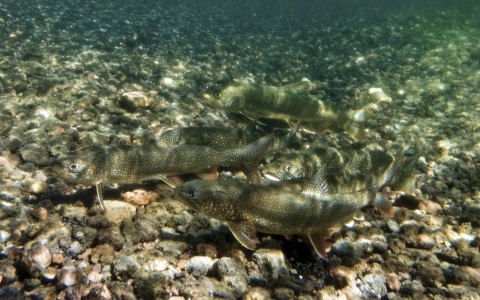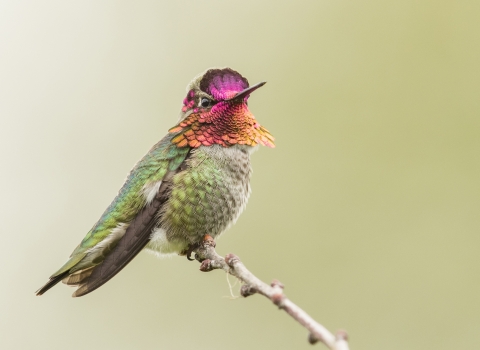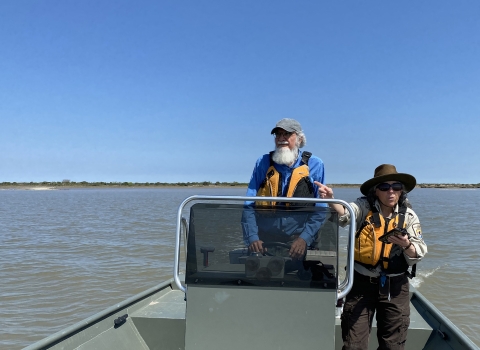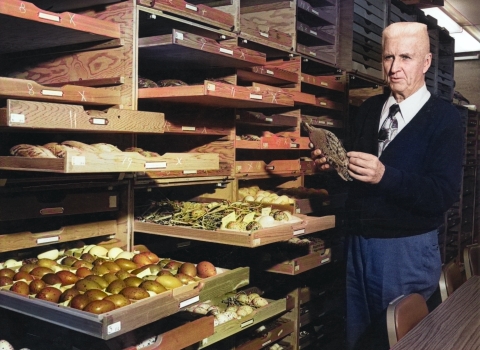Steve Hurst recalls a cold, stormy, November night in a boat on Lake Champlain 35 years ago. He and others were harvesting lake trout eggs to create a line of hatchery-raised fish to be stocked in the lake. At the time, a wild population seemed out of the question.
Not anymore.
While the “Lake Champlain broodline” is still producing, their young are now headed elsewhere. After decades of work by dozens of people, Champlain’s lake trout are self-sustaining, and stocking is no longer needed.
Hurst, now chief of fisheries for the New York Department of Environmental Conservation, sits on the management committee for the Lake Champlain Fish and Wildlife Management Cooperative. Since 1972, the cooperative has brought together fisheries professionals from New York and Vermont, as well as the U.S. Fish and Wildlife Service, to manage lake trout, landlocked Atlantic salmon and invasive sea lamprey in the lake.
Guided by its strategic plan for lake trout restoration, which includes benchmarks for success, the cooperative has ceased annual stocking after meeting its target for natural reproduction.
Five million in five decades
Though native to Lake Champlain, lake trout disappeared from the lake in the early 1900s, for reasons that are still unclear. New York and Vermont started stocking the lake, which runs more than half the length of their border, with lake trout strains from other water bodies in the late 1950s.
Hurst’s chilly expedition in 1990 was part of a plan by Vermont to produce a captive broodline of trout adapted to conditions in the lake.
“The lake trout collected from Champlain were stocked fish that had survived to maturity, and the hope was that they represented some genetic makeup that might have some survival advantages,” said Eric Palmer, director of fisheries for the Vermont Fish and Wildlife Department.
For the last 30 years, Lake Champlain-strain adults at Vermont’s Salisbury Fish Culture Station have produced eggs that are transferred to Ed Weed Fish Culture Station in Grand Isle, Vermont, to be raised to stocking size.
New York continued to contribute to stocking until 2020. In the last half-century, more than five million lake trout have been released into the lake.
Plagued by a parasite
After decades of stocking, however, it became clear nonnative, invasive sea lamprey were taking a toll on lake trout ... and growing in number due to the additional food source.
Native to the Atlantic Ocean, sea lamprey play an important role in ocean and coastal river ecosystems. But in the wrong waters, where there are few natural predators, these voracious feeders can cause havoc. They were first observed in Lake Champlain in the 1920s.
Lamprey latch onto host fish with their toothy, suction-cup mouths and siphon off body fluids, seriously injuring or killing the hosts. They also prey on the lake’s landlocked Atlantic salmon and lake sturgeon.
In 1990, the cooperative, along with the Great Lakes Fishery Commission, launched an eight-year experimental sea lamprey control program in Lake Champlain, supported by funding from the Service's Sport Fish Restoration program. To restrict lamprey reproduction in the lake’s tributaries, they added physical barriers, applied chemicals that kill larval lamprey — with minimal effects on other aquatic life — and trapped and removed adults before they could spawn.
The effort was effective and continues today, overseen by the Service since 2011.
“Each year, we invest $1.7 million to control sea lamprey in Lake Champlain, which results in a nearly $6 million economic gain to the region,” said Laurie Earley, the Service’s project leader at the Lake Champlain Fish and Wildlife Conservation Office in Essex Junction, Vermont.
To inform control efforts, Service biologists routinely assess more than 200 tributaries to Lake Champlain — from large rivers to small streams — for the presence of sea lamprey. Lamprey wounding rates — determined by the telltale round marks lamprey leave behind on hosts — dropped from 99 per 100 lake trout in 2006 to 23 per 100 in 2022. Since then, it’s hovered near the cooperative’s goal of 25 per 100.
Encouraging as that is, no one expects to declare victory over sea lamprey anytime soon. Long-term vigilance is essential, to prevent populations from rebounding.
“I can't say enough about the Northeast U.S. Fish and Wildlife Service staff ... extraordinary individuals that are just totally committed and cutting edge with what they do,” Hurst said. “We can't take that for granted, because if that ever goes away, we will lose all of this, and we will lose it quickly.”
Seeking new recruits
Sea lamprey weren’t the only challenge to restoring a wild population of lake trout to Lake Champlain.
Every year, tens of thousands of young, hatchery-reared lake trout — marked by clipping off a fin before stocking — were released into the lake. And well into this century, 50 years after stocking began, their offspring failed to reach adulthood.
J. Ellen Marsden, professor emerita at the University of Vermont, is a member of the cooperative’s Fishery Technical Committee. After studying lake trout in the Great Lakes, she moved to the university’s Rubenstein Ecosystem Science Laboratory in Burlington nearly 30 years ago. She’s the foremost expert on the ecology, behavior and genetics of Lake Champlain’s lake trout population.
On research dives to the depths where lake trout live, Marsden confirmed the stocked lake trout were spawning and producing young but found no wild-reared juveniles. Meanwhile, surveys by Vermont Fish and Wildlife found no wild adults.
“We were seeing spawning; we were taking eggs into the hatchery, and they were viable; but we weren't seeing young lake trout in the lake,” Palmer said.
Then, in 2015, with a new boat captain skilled at sampling for juvenile trout using a large net called a trawl, Marsden discovered the first young lake trout that hadn’t been stocked.
“We hauled a trawl through the lake ... it came up, and it was full of juvenile lake trout,” Marsden recalled. “And about a third of them were unclipped.”
In subsequent years, gillnetting surveys and sea lamprey wounding studies found substantial numbers of wild-reared fish that were four, five and six years old — proof that young, wild fish were surviving and being “recruited” into the population. It turned out recruitment had begun in 2012.
Soon, the number of wild trout in Lake Champlain triggered a reduction in stocking.
“New York stopped stocking in 2020 based on a measurement that we had in our strategic plan,” Hurst said. “We had thresholds that were set for natural reproduction indicators that told us, okay, at this point, we've got to back off.”
A decade after proof of recruitment, stocking is no longer needed.
Wild is the way to go
Early on, a wild lake trout population wasn’t the goal. Stocking sport fish like lake trout is a time-honored tool for supporting recreational fishing, which generates about $474 million in economic activity annually on Lake Champlain.
“We'd have meetings originally, and the program was really focused on just restoring a fishery,” Palmer said. “Over time, that evolved into seeing what we could do to restore natural reproduction and get a self-sustaining fishery.”
Why bother?
Beyond saving resources required for stocking, Marsden points out that a wild population is responsive to its environment in a way that a stocked population is not. Managers decide how many trout to stock in a given year based on available data, but lake trout can live up to 50 years, and habitat conditions can change in that time.
A wild population, however, responds to undesirable environmental factors in a given year by producing fewer young.
“The fish are part of a system, whereas a hatchery by definition is outside,” she said. “With stocking, we’re looking at the system trying to make sure we know as much about the metrics as possible and hoping we've got it right.”
Put another way, natural, self-sustaining populations are resilient to change. That makes them more stable in the long run, contributing to more resilient communities and ecosystems.
“It's more important than ever that we have natural, wild populations of not just lake trout, but of all our native species, because the environment is changing at a very rapid rate right now,” Hurst said.
A lake that supports fish at all life stages — from spawning through adulthood — displays a level of health a lake that supports only stocked fish doesn’t.
And the value of high-quality recreational experiences — to the individual and the region — can’t be overstated.
“To be able to bring people to Lake Champlain, where they can have some of the best fishing they've experienced, is amazing,” Earley said. “Because people remember it, and they choose to come back.”
What’s next?
The partners agree their work isn’t done.
Monitoring indicators such as growth rate and condition of the lake trout population is crucial. They plan to assess prey populations — rainbow smelt and alewife — through trawling, gillnetting and hydroacoustics, which uses sonar to show fish at depth.
Sea lamprey control must continue, while the threat of new invasive species invasive species
An invasive species is any plant or animal that has spread or been introduced into a new area where they are, or could, cause harm to the environment, economy, or human, animal, or plant health. Their unwelcome presence can destroy ecosystems and cost millions of dollars.
Learn more about invasive species is constant.
“Lake Champlain is connected to the Saint Lawrence River on the north end and the Hudson River on the south end, so one of our ongoing concerns is invasive species, which can change the ecosystem,” Palmer said.
Fish diseases, habitat loss and algal blooms round out the list of potential threats.
“Lake Champlain is still a managed system, and it’s still an exploited system,” Marsden said. “It’s still subject to issues such as global climate change climate change
Climate change includes both global warming driven by human-induced emissions of greenhouse gases and the resulting large-scale shifts in weather patterns. Though there have been previous periods of climatic change, since the mid-20th century humans have had an unprecedented impact on Earth's climate system and caused change on a global scale.
Learn more about climate change , the next exotic species. There are still unpredictable events happening, so the job of management, now, both federal and state, is to keep an eye on things.”
And the lake still holds a secret: What changed to allow lake trout to reproduce successfully? The answer could guide future success in Lake Champlain and elsewhere.
“We do most of our work in direct collaboration with people working on the Great Lakes,” Marsden said. “We're learning from them, and they're learning from us, and at the moment, they're going, ‘Whoa, what did you just do?’”
One thing is clear: Lake trout restoration in Lake Champlain didn’t happen by chance.
“There's something that is overlooked quite a bit, and that is the passion and dedication of the people involved,” Hurst said. “Everyone at every level cares deeply about it, and I think that caring brings with it a level of commitment to get work done.”











